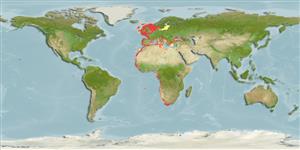Preferred temperature (ссылка
123201): 7.1 - 18, mean 10.8 °C (based on 667 cells).
Phylogenetic diversity index (ссылка
82804): PD
50 = 0.5020 [Uniqueness, from 0.5 = low to 2.0 = high].
Bayesian length-weight: a=0.00457 (0.00413 - 0.00505), b=3.10 (3.07 - 3.13), in cm total length, based on LWR estimates for this species (Ref.
93245).
Trophic level (ссылка
69278): 3.1 ±0.36 se; based on food items.
Generation time: 2.0 (1.6 - 2.8) years. Estimated as median ln(3)/K based on 47
growth studies.
устойчивость к внешним воздействиям (ссылка
120179): средний (среднего размера), минимальное время удвоения популяции 1.4-4.4 года (K=0.3-1.73; tmax=6; Fec =13,000-503,000).
Prior r = 0.59, 95% CL = 0.39 - 0.89, Based on 21 full stock assessments.
Fishing Vulnerability (Ref.
59153): Low to moderate vulnerability (29 of 100).
🛈
Climate Vulnerability (Ref.
125649): Low vulnerability (9 of 100).
🛈
Nutrients (Ref.
124155): Calcium = 170 [78, 369] mg/100g; Iron = 1.21 [0.63, 2.85] mg/100g; Protein = 18.7 [17.6, 20.0] %; Omega3 = 0.976 [0.611, 1.574] g/100g; Selenium = 19.1 [9.3, 36.9] μg/100g; VitaminA = 15.5 [4.4, 51.5] μg/100g; Zinc = 1.24 [0.79, 1.84] mg/100g (wet weight); based on
nutrient studies. 